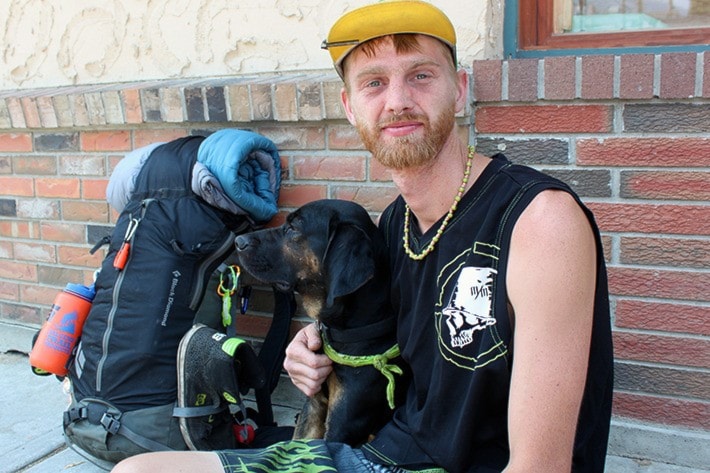Nelson’s homeless problem was highlighted when a squatter’s camp on CPR property west of the city was dismantled in June (pictured below, left). Of five occupants evicted, three left voluntarily, while two others were reluctant to go.
 The camp, informally known as Railtown, was reportedly active for eight years and had up to 40 people at its peak. District transportation manager Hugh Eberle said they were aware of the site and a number of others for a while. This one was problematic because of human waste and garbage that accumulated. “Not only is it a wildlife attractant, it’s a public health issue,” he said. “It was a huge job cleaning up this mess.”
The camp, informally known as Railtown, was reportedly active for eight years and had up to 40 people at its peak. District transportation manager Hugh Eberle said they were aware of the site and a number of others for a while. This one was problematic because of human waste and garbage that accumulated. “Not only is it a wildlife attractant, it’s a public health issue,” he said. “It was a huge job cleaning up this mess.”
RCMP, the Nelson Police Department, Canadian Pacific Railway, Nelson Fire and Rescue, and other city workers attended. Various tents and other structures were taken down and disposed of.
Adam Hutchison, 29, who had lived there since April was among those told to leave.
“I woke up to a number of officers asking me to exit what was my friend’s wigwam,” he said. He had returned to the camp the night before after his dishwashing shift at the Adventure Hotel. He lived there with his dog Duke.
A woman who asked to be identified only as Jade was heartbroken. “We were all staying on the side. We weren’t even on railroad property. There were some people making a mess, but lots weren’t. We just needed a place to stay.”
But another resident, who only gave his name as Trevor, said concerns about cleanliness were well founded. “There was a big effort to do a mass cleanup of garbage, and from what I’ve seen, [there] must’ve been years of trashing the place.”
Ann Harvey of the Nelson Committee on Homelessness said the situation was the inevitable outcome of a housing shortage, as identified by the group’s annual report card. It found Nelson is failing to adequately support the homeless, including youth, seniors, and people with mental illness.
The number of food bank visits and meals served at Our Daily Bread increased since 2011, and the average length of stay at the local shelter has risen by nearly a week.
 Pastor Jim Reimer of Kootenay Christian Fellowship (pictured at left), who was concerned at the level of resources poured into removing the camp, proposed designating a piece of land as a campground where homeless people could sleep, eat, use washroom facilities, receive messages, and meet service providers.
Pastor Jim Reimer of Kootenay Christian Fellowship (pictured at left), who was concerned at the level of resources poured into removing the camp, proposed designating a piece of land as a campground where homeless people could sleep, eat, use washroom facilities, receive messages, and meet service providers.
“The homelessness issue certainly isn’t going away,” he said. “A secure outdoor space would solve a whole host of problems.” He stressed his idea was to address the local homeless population, not the transient one, which would have to be dealt with separately.
The alternative, he said, would be another squatters’ camp, minus the sanitation and security measures he envisioned.
He asked city council to pitch in $5,000 toward a feasibility study. Council referred the request to the Nelson Housing Committee, a group with representation from non-profit housing providers, would-be providers, landlords, and the community-at-large.
But then-councillor Donna Macdonald explained the committee wasn’t sure what group was sponsoring the project and felt it “seemed like moving to a solution before we understand the problem.”
They recommended the city decline the funding request but ask the Nelson Committee on Homelessness if it or one of its member agencies could tackle a phased approach to the issue, starting with determining how great the need is. While disappointed, Reimer didn’t think the concept was dead. “We’re just going to revisit it and see how we can move forward,” he said.
Affordable housing was a familiar refrain during the election campaign. New mayor Deb Kozak said during council’s inauguration that while the city isn’t going to become a housing provider, it can work with groups like BC Housing to ensure there are more low-income units.
 A consultant who updated the city’s affordable housing strategy found the city could use 110 to 180 more units to meet the demands of various groups struggling to find places to live. It listed 20 things the city could do, including adopting an infill housing policy and a standards of maintenance bylaw.
A consultant who updated the city’s affordable housing strategy found the city could use 110 to 180 more units to meet the demands of various groups struggling to find places to live. It listed 20 things the city could do, including adopting an infill housing policy and a standards of maintenance bylaw.
Meanwhile, Nelson CARES launched its Room to Live campaign (pictured at left), which aims to raise the final $690,000 needed to carry out the redevelopment of the apartments at Ward Street Place.
CARES, which receives no public funding to operate the funding, had already raised $2.2 million to complete health and safety improvements and move Stepping Stones shelter to a new site, but is seeking enough to upgrade each room and common living spaces. The city gave $15,000 from its affordable housing fund, enough to fix up one apartment and provide for ongoing maintenance.
“There are as many reasons that people come here as there are people,” said Sam, a tenant for ten years. “I thank God I found this place. It’s a safe haven.”
